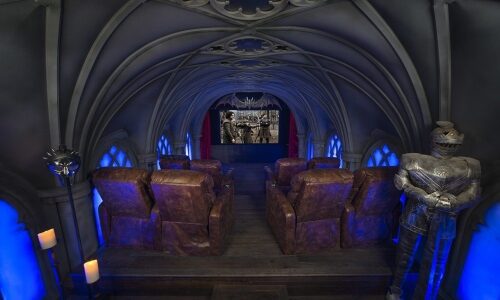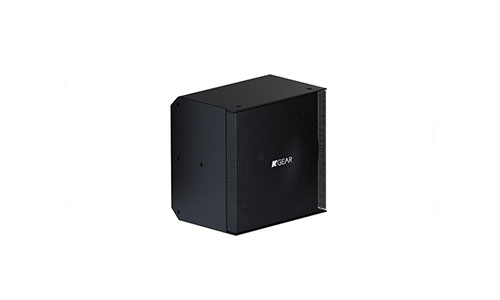Think about any performance you attend – be it a Broadway musical, three-ring circus or all-day rockfest. The prelude to the show often sets the tone for the entire experience. The same goes for a home theater, and one of the most effective ways to build up to the big action is with sensational lighting.
Decorative sconces and recessed can lights combined with LED strips around moldings and steps are just the start of what’s possible when you let your creativity take over. You can use tiny fixtures to frame movie posters, accentuate a mural on the ceiling or draw attention to a well-dressed rack of equipment.
1. Take the Lighting Temperature into Consideration
The color temperature of lighting can have a direct impact on the quality of home theater video, says Dennis Erskine of Atlanta-based Erskine Group.
“For the best experience, any lights that are on in a theater should be set at 6,500 degrees Kelvin,” he says. “Anything else will change the color fidelity of the image on the screen. Yellows become green, for example.”
Erskine says that dimmable LEDs are the only type of light source, besides fluorescent, that can be dialed in to this ideal color temperature.

The Future of Digital Lighting & Control
As a custom integrator, lighting is in demand. Effective communication, education and showcasing the value proposition of LED light fixtures in conjunction with integrative control systems are the keys to overcoming challenges and closing sales in this specialized market. Join us as we discuss the future of digital lighting and control with David Warfel from Light Can Help You and Patrick Laidlaw and Mark Moody from AiSPIRE. Register Now!2. Genre Match the Lights to the Content
Be sure to set the lights to match the tone of the video.
Include lighting in any scenes created for different types of genres such as music videos, children’s shows, dramas, news and games. For example, pressing the “news” button on a keypad might switch the TV to CNN and set the audio to a “dialog” setting, while keeping the lights to full on for performing other tasks. A “movie” scene would turn on the server, set the “sound stage” appropriately and turn off all lights in the areas except pathway LEDs.
3. Use Lighting to Highlight Noteworthy Parts of the Home Theater
What is an audiophile to do if he or she wants to show off their awesome theater speakers but not detract from the home theater experience?
One sound-loving homeowner had San Diego-based Audio Impact design an elegant theater room with two speaker cavities built into custom cabinetry at the front of the room. Monitor Audio Platinum tower speakers would stand in the cavities hidden from view by black cloth – most of the time. But when the room is “on” and the video is off, an array of LED lights within the cavity would illuminate the speakers.
4. Set a Specific Theme
In this home theater, the homeowners paid homage to their favorite movie, “Star Wars,” by installing off-the-shelf multi-colored light sabers on the wall. But the pros at Admit One Home Cinema in Edina, Minn., turned the battery-operated devices into theater showpieces with a little automation.
“The homeowners wanted the light sabers to play a role by turning on and off as they entered and exited the room,” explains Admit One’s Lance Anderson.
To achieve that, the company linked each saber to a Lutron lighting control system that would be triggered an RTI home control system.
5. Define the Architecture of the Home Theater with Accent Lighting
Design-conscious homeowners want to show off their architectural details, even when a space is dark. A good way to do that is by using strategically placed (and controlled) lighting. Admit One Cinema brought sophistication, spaciousness and drama to this home theater through custom-made LED soffits for key areas of the room.
Built into the 225 linear feet of LED tape are hundreds of individual LED bulbs. The trick, explains president Lance Anderson, was to install the tape in a way that would hide the bulbs but would still adequately illuminate the area. The solution came in the form of a specially constructed molding. Conceived after several month of testing at the Admit One offices, the wooden molding was hollowed out so that the tape could be nestled inside, hidden completely from view.
In addition to providing general illumination, the blue LEDs define the perimeters of several columns and steps, and add definition and depth to an oval-shaped fiber-optic starfield on the ceiling.
“The use of the fiber optic starts and blue LED lighting makes the ceiling look higher than it actually is,” says Anderson.
6. Group Up the Lighting
Home theater designer Theo Kalomirakis Group suggests grouping lights together on individual circuits, or zones.
“Column lights on one circuit, step lights on another, curtain lights on another … so you can play with levels, bring certain lights up and down to the client’s wish,” he says.
He likes to sit down with the client after an installation is complete to tweak the lighting settings, asking for example, “Do you like this light 40 percent down, or 50 percent down?”
If you enjoyed this article and want to receive more valuable industry content like this, click here to sign up for our digital newsletters!











